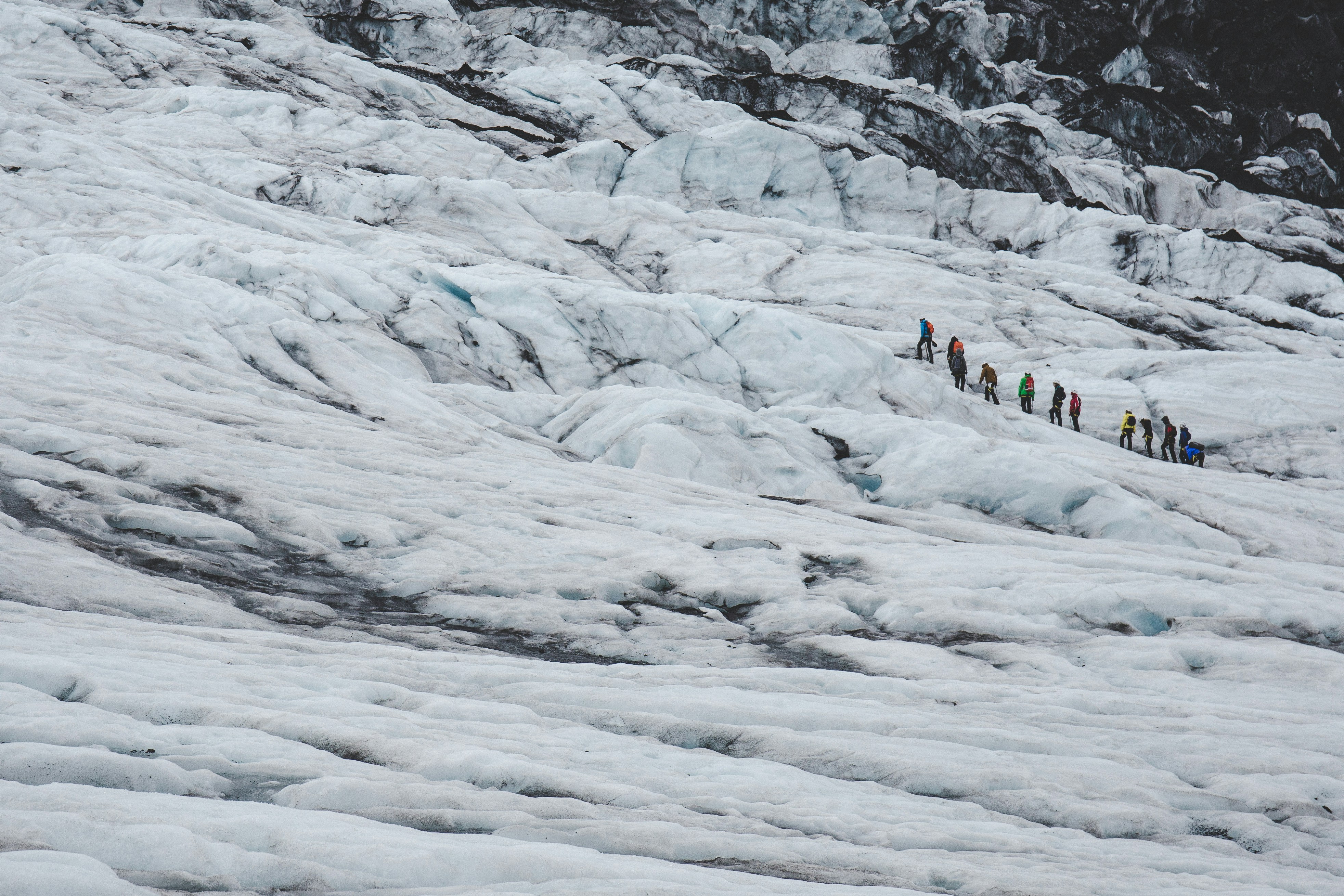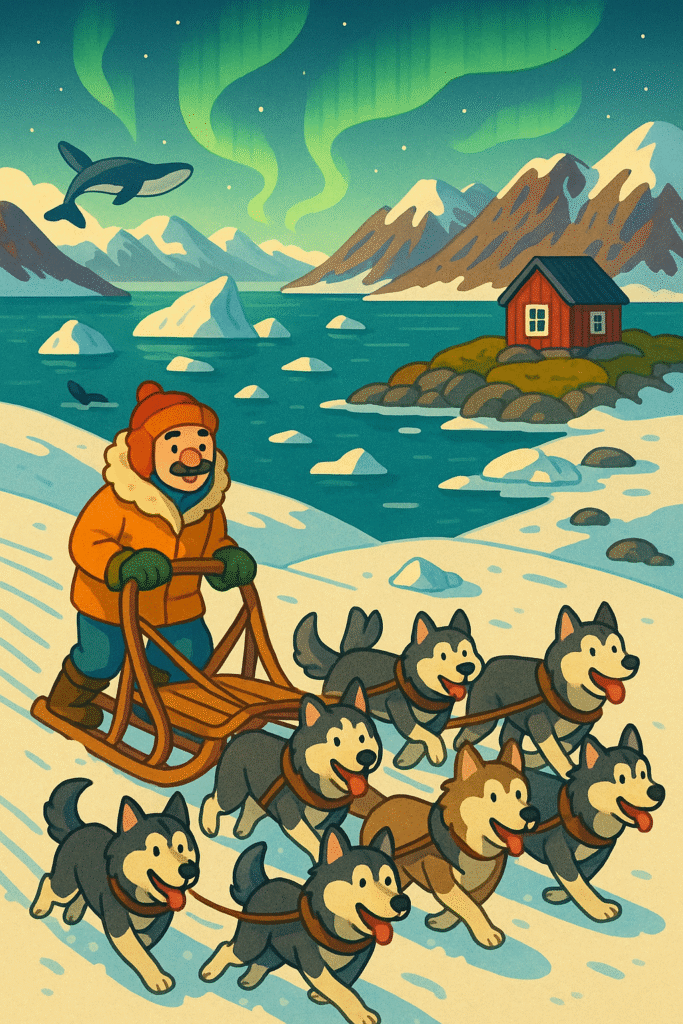Table of Contents

Introduction to Greenland’s Untamed Beauty
Greenland, often referred to as the world’s last great wilderness, is a land of stunning natural contrasts and vibrant cultural heritage. This vast island, predominantly covered by ice, presents an extraordinary tableau of unspoiled landscapes characterized by towering glaciers, remote fjords, and breathtaking tundra. The sheer scale of Greenland’s beauty invokes a sense of awe in those lucky enough to witness its iconic scenery, where magnificent icebergs drift through cobalt-blue waters and majestic cliffs rise against the horizon.
As one traverses this breathtaking environment, the solitude and tranquility found within its landscapes offer a unique escape from modern life. The vast, untamed wilderness provides an opportunity for exploration, adventure, and reflection, as visitors are invited to connect with nature in its purest form. Rich in natural resources, Greenland’s terrain is not only visually striking but also crucial for scientific research and environmental studies, revealing insights into climate change and Earth’s geological history.
The cultural aspect of Greenland adds an exciting layer to its natural allure. The vibrant Inuit culture, with its deep-rooted traditions and resilient way of life, showcases a harmonious relationship between the people and their environment. Visitors often find themselves captivated by the stories and practices of the Inuit, who have thrived in this rugged landscape for centuries. Their customs, artistry, and knowledge of the land enrich the experience of those who embark on this journey.
In essence, Greenland embodies a remarkable blend of nature and history, making it a compelling destination for those seeking adventure in one of the last frontiers on Earth. The draw of untamed beauty, coupled with the rich tapestry of cultural heritage, offers an unparalleled experience, enticing explorers to delve into the heart of this awe-inspiring wilderness.
How to Get There: Travel Logistics
Reaching Greenland, an enigmatic destination known for its stunning wilderness and dramatic landscapes, requires careful planning and consideration of various travel logistics. Given its unique geographical position, most travelers will begin their journey from major gateways, with Reykjavik in Iceland being the most common starting point. Direct flights from Reykjavik to Greenland are available and typically serve destinations such as Nuuk, Kangerlussuaq, and Ilulissat. Several airlines operate these routes, facilitating a relatively straightforward passage into the heart of this Arctic paradise.
Beyond air travel, ferry services also play a crucial role in connecting various towns and settlements within Greenland. Travelers may choose to take a ferry from Iceland to Greenland, allowing for a scenic perspective of the coastline and surrounding waters. These ferries primarily operate during the summer months, so it is essential to check schedules and availability ahead of your planned travel dates.
When planning your trip, considering the best times to visit Greenland is paramount. The summer months, from June to August, offer milder weather and longer days, making them ideal for outdoor adventures such as hiking and whale watching. Conversely, the winter months provide a unique experience, attracting visitors eager to witness the Northern Lights. However, winter travel necessitates more extensive preparation due to colder temperatures and potential weather challenges.
Travelers should also be aware of potential permit requirements for certain activities, especially those that involve national parks or protected areas. Additionally, packing appropriately for Greenland’s varying climates is crucial; sturdy outdoor gear, thermal clothing, and essential supplies should all be included to ensure a safe and enjoyable experience. In preparation for such an adventure, conducting thorough research and preparing accordingly will enhance your journey through this magnificent wilderness.
Navigating the Wilderness: Modes of Transportation
Exploring Greenland’s expansive wilderness presents unique challenges and opportunities, making it imperative to select the appropriate mode of transportation. Each method brings its own advantages and drawbacks, enabling adventurers to tailor their journeys according to personal preferences and environmental conditions.
Hiking is one of the most immersive ways to experience Greenland’s breathtaking landscapes. With trails ranging from moderate to challenging, hikers can witness the pristine beauty of glaciers, fjords, and rugged mountains. While the slower pace allows for a deep connection with nature, hikers must be prepared for the unpredictable weather and variable terrain. Essential gear, including sturdy footwear and weather-appropriate clothing, is vital for a safe and enjoyable trek.
For those seeking a more traditional means of traversing the snowy expanses, dog sledding offers a unique cultural experience. This ancient practice provides insight into the traditions of the Inuit people while allowing participants to glide over the snow with the help of a well-trained team of sled dogs. Although thrilling, dog sledding requires careful consideration of animal welfare and weather factors, making it best suited for more adventurous souls willing to embrace the elements.
An alternative method of transport is snowmobiling, which offers speed and accessibility. Snowmobiles allow adventurers to cover larger distances, making it possible to reach remote areas in shorter timeframes. This option is particularly beneficial for those wanting to explore more rugged terrains, although navigational skills are essential for safe travel across vast, icy landscapes. Additionally, snowmobiling tours often include experienced guides who can share insights about the environment and local wildlife.
Finally, boat tours provide a scenic view of coastal areas and icebergs, marrying adventure with relaxation. Greenland’s waterways serve as vital conduits for travel, offering picturesque views that are often inaccessible by land. While boat trips allow for enjoyable sightseeing, they may be subject to weather conditions and require careful planning to ensure safety and convenience. Opting for mixed-mode travel, such as pairing hiking and boating, can further enhance the overall experience.
In considering these various modes of transportation, travelers can select a combination that aligns with their interests and desired endurance levels, ensuring a memorable exploration of Greenland’s stunning wilderness.
Discovering Local Culture: The Inuit Heritage
The Inuit people, indigenous to the Arctic regions of Greenland, possess a rich cultural heritage that showcases resilience and adaptability. Their traditional practices are deeply rooted in the harsh realities of their environment, with a lifestyle historically reliant on hunting, fishing, and gathering. Modern influences have begun to intermingle with these age-old customs, yet the Inuit strive to preserve their unique identity amidst this change.
One of the most significant aspects of Inuit culture is their storytelling tradition, which serves as an essential tool for passing down values, history, and communal knowledge. These narratives are often steeped in the natural world, reflecting the people’s profound connection to their surroundings. Through the oral transmission of stories, younger generations learn about their ancestors, pivotal events, and moral lessons that shape their worldviews. This emphasis on storytelling not only strengthens community bonds but also fosters a sense of belonging and continuity.
Handicrafts play a crucial role within Inuit society, showcasing artistic skill and cultural significance. Crafts such as intricately carved bone and stone sculptures, as well as beautifully crafted clothing made from animal skins, highlight the resourcefulness of the Inuit in using materials at hand. These items are often imbued with symbolism and convey stories or beliefs that are intrinsic to the Inuit identity. As such, engaging with these crafts presents travelers with the opportunity to appreciate the artistry while supporting local artisans.
Community life remains central to the Inuit experience, emphasizing cooperation and sharing. The importance of collective well-being is reflected in traditional activities, such as communal hunting and gatherings. As travelers seek to explore Greenland, understanding and respecting the Inuit heritage is paramount. This careful approach fosters cultural appreciation and promotes sustainability, allowing visitors to connect with the Inuit people in a meaningful way while ensuring their traditions endure amidst modernization.
Alpine Adventures: Hiking and Outdoor Activities
Greenland, often referred to as the last great wilderness, offers an unparalleled playground for outdoor enthusiasts. With its dramatic landscapes, encompassing rugged mountains, expansive ice sheets, and breathtaking fjords, the opportunities for adventure are practically limitless. Hiking stands out as one of the most popular activities, with numerous trails that cater to various skill levels. For beginners, the short and scenic paths around the capital city of Nuuk offer gentle slopes and stunning views, allowing newcomers to acclimatize to the majestic scenery.
Intermediate hikers may find the trails in the Disko Bay region particularly appealing. The trek from the town of Ilulissat to the famous Ilulissat Icefjord presents a mixture of slightly challenging terrains while rewarding hikers with views of massive icebergs calving from the Sermeq Kujalleq glacier. For more experienced adventurers, the Arctic Circle Trail, stretching over 160 kilometers, is a must. This trail offers a true wilderness experience, passing through untouched landscapes and providing opportunities for unforgettable wildlife encounters.
In addition to hiking, kayaking in glacial waters is another thrilling way to experience the pristine beauty of Greenland. Paddling among icebergs allows adventurers to connect with the ecosystem on a more intimate level. Guided tours are highly recommended for both hiking and kayaking, as local experts can provide valuable insights into the natural environment and ensure safety while navigating through challenging terrains or waters.
Safety is paramount when exploring Greenland’s wilderness. It is essential to dress in layers, as weather conditions can change rapidly. Moreover, always inform someone about your hiking plans and estimated return time. Hiring a guide can enhance your experience, providing both knowledge and assurance as you journey through the breathtaking landscapes. Embarking on outdoor activities in Greenland promises to be a remarkable adventure, filled with extraordinary sights and experiences.
Wildlife Encounters: A Close-Up with Nature
Exploring Greenland’s wilderness offers an unparalleled opportunity to encounter a variety of wildlife in their natural habitats. The pristine landscapes of this vast region serve as a home for some of the most remarkable species on the planet. Among these, the polar bear stands out as one of the most iconic symbols of the Arctic. Travelers may find themselves mesmerized by the sight of these majestic creatures roaming the icy terrain or foraging along the coastlines. The best chances to view polar bears occur during the spring and summer months, particularly from April to August when the ice begins to thaw and they venture further inland.
In addition to polar bears, Greenland is renowned for its impressive marine wildlife. Whales, including humpback and minke species, can often be seen during the summer months, particularly in the fjords surrounding Disko Bay. Whale watching tours have become increasingly popular, allowing visitors to witness these magnificent animals breaching and feeding in their natural environment. Responsible tourism practices are crucial during whale watching; maintaining a respectful distance and avoiding disturbance to their social behavior is imperative.
Seals are another captivating aspect of Greenland’s wildlife. The waters around the island play host to various species, such as the ringed seal and harp seal. These animals can frequently be spotted relaxing on ice floes in the warmer months or swimming gracefully beneath the surface. Birdwatching enthusiasts will not be disappointed either; Greenland boasts a rich avian population including puffins, guillemots, and various migratory species that come to nest during the summer season. Whether observing majestic polar bears, graceful whales, or the vibrant birdlife, the wildlife of Greenland promises unforgettable encounters. These experiences emphasize the importance of sustainable practices to ensure that future generations can continue to admire these extraordinary creatures in their natural habitat.
The Last of the Ice: Glaciers and Climate Change
Greenland is renowned for its breathtaking glacial landscapes, which represent some of the world’s last great wildernesses. The vast expanses of ice are not only visually captivating but also serve as vital ecosystems that support diverse wildlife. Among the notable glaciers to visit are the Jakobshavn Glacier and the Sermeq Kujalleq, both of which are iconic for their massive ice structures and dynamic calving processes. Ice calving occurs when chunks of ice break off from the edge of a glacier, creating spectacular displays as towering icebergs crash into the ocean. This natural phenomenon is a breathtaking sight, yet it serves as a stark reminder of the ongoing transformations due to climate change.
The reality of climate change is exceptionally pronounced in Greenland, with rising temperatures contributing to the accelerated melting of its glaciers. Research indicates that Greenland’s ice sheet has been losing approximately 400 billion tons of ice annually over the past few decades. This alarming trend not only threatens local ecosystems, which depend on the ice for habitat stability, but also poses a significant risk to global sea levels. The melting glaciers contribute directly to rising ocean levels, potentially displacing millions of people worldwide and irrevocably altering coastlines.
Furthermore, the visible signs of climate change can be seen throughout the region. Glacial retreats are becoming more common, with many of Greenland’s once-mighty ice formations shrinking at an unprecedented rate. As the glaciers recede, they reveal underlying landscapes and soil structures that have remained buried for millennia, leading to shifts in local ecosystems. These changes align with broader global climate trends, emphasizing the urgent need for conservation and climate action to protect not only Greenland’s glaciers but also the planet as a whole. Understanding the intricate relationship between Greenland’s icy landscapes and the effects of climate change is essential for addressing these pressing environmental challenges.
Unique Accommodations: Where to Stay
Greenland offers a diverse range of accommodations that enhance the experience of exploring its vast, pristine wilderness. Adventurous travelers can choose from cozy guesthouses, eco-lodges, luxury hotels, and even camping opportunities to immerse themselves in the landscape. Each type of lodging boasts distinctive features that cater to varied preferences and budgets while viewing sustainability as a priority.
Guesthouses in Greenland provide an intimate setting for visitors, often run by local families who share their homes and insights into Greenlandic culture. These humble lodgings typically offer comfortable rooms and homemade meals, allowing travelers to unwind after a day filled with exploration. Common amenities include communal spaces where guests can relax and share stories, fostering a sense of community amidst the stunning surroundings.
For those seeking a more environmentally friendly option, eco-lodges present a perfect blend of comfort and sustainability. Constructed with local materials and employing green technologies, these lodgings minimize their impact on the environment while promoting the preservation of Greenland’s natural beauty. Eco-lodges often feature spectacular views of the rugged landscape or glimmering glaciers, offering guests an unforgettable backdrop for their stay.
Luxury hotels in Greenland present a more opulent experience, providing high-end amenities and personalized service. Many of these establishments boast prime locations that allow guests to experience the Northern Lights or the breathtaking fjords right outside their windows. Indulging in gourmet dining, spa treatments, and guided excursions, guests can enjoy the best of both worlds: a lavish retreat amid untamed wilderness.
Lastly, those seeking a true connection with nature can opt for camping under the stars. Several campgrounds and guided camping tours allow individuals to set up tents in some of the world’s most beautiful natural settings. This option enables visitors to experience the tranquility of Greenland’s wilderness first-hand, fostering a unique connection to the land.
Conclusion: Embracing the Spirit of Adventure
Exploring Greenland offers a unique opportunity to connect deeply with one of the last great wildernesses on our planet. This remarkable destination is not just a geographical location; it is a rich tapestry of natural beauty and cultural significance that has the power to transform a traveler’s perspective on nature and adventure. The breathtaking landscapes, from majestic fjords to sprawling ice sheets, invite an appreciation of the delicate balance between humanity and the environment.
As visitors traverse the rugged terrain and immerse themselves in Greenland’s unique culture, they may discover a renewed sense of adventure that extends beyond the physical journey. Each trek across the ice or encounter with local communities unveils stories of resilience and connection. This profound engagement with both the land and its people encourages travelers to recognize their place within this expansive ecosystem, fostering a deeper sense of responsibility toward the preservation of such unspoiled beauty.
Travelers are urged to approach their explorations with a mindset centered on sustainability and respect for Greenland’s delicate environments. Embracing the spirit of adventure goes hand in hand with a commitment to responsible travel practices that honor both the natural landscape and the indigenous cultures. Each visit has the potential to contribute positively to the local economy and support initiatives aimed at safeguarding Greenland’s natural heritage for future generations.
As you consider your next journey, let the charm of Greenland’s wilderness inspire you to embrace adventure in its truest form. By adventuring responsibly, you not only enrich your own experience but also play a vital role in preserving the extraordinary beauty and cultural legacy of this captivating destination. It is through such journeys that we can collectively ensure that the wonders of Greenland continue to be cherished and protected for years to come.






